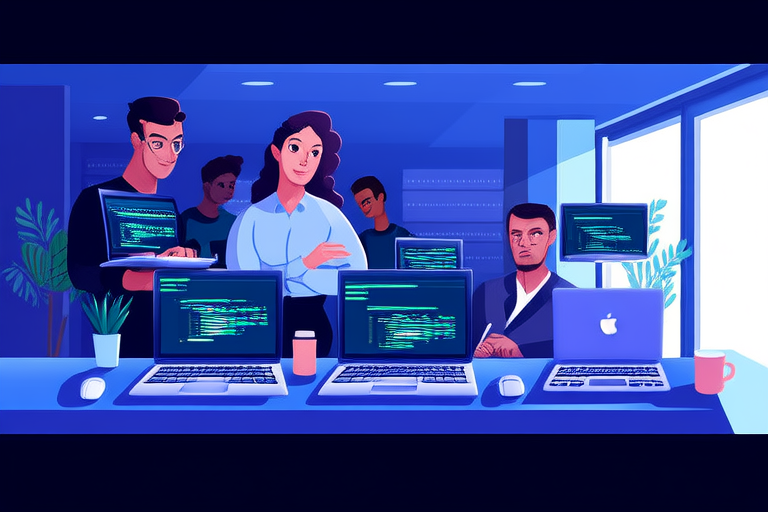“`html
Collaborate and Contribute: Leading Open Source Projects Shaping the Future
Introduction
Open source projects have become a cornerstone of modern technological advancement. These initiatives, characterized by their collaborative nature and transparent development processes, allow individuals and organizations from around the world to work together toward a common goal. At the heart of open source lies the principle of sharing and contributing, which fosters innovation and drives progress.
The essence of collaboration and contribution in open source projects cannot be overstated. By pooling resources, expertise, and ideas, developers and enthusiasts can create powerful tools and solutions that would otherwise remain out of reach. This collaborative approach not only accelerates the pace of innovation but also ensures that the resulting technologies are accessible to a broader audience. In doing so, open source projects play a pivotal role in shaping the future of technology, democratizing access to cutting-edge tools and fostering a culture of continuous improvement.
The impact of open source on the tech industry is profound. From software development to hardware design, open source projects have transformed industries by enabling greater flexibility, interoperability, and cost-effectiveness. As we look ahead, the role of open source in driving technological advancements will only grow more significant, making it an essential component of the future landscape.
Key Characteristics of Open Source Projects
An open source project is defined by several key characteristics. First and foremost, the source code of the project is openly available for anyone to view, modify, and distribute. This transparency ensures that users can verify the integrity and security of the software, fostering trust within the community. Additionally, open source projects encourage community involvement, where individuals and organizations can contribute to the development process, whether through coding, documentation, or testing.
The benefits of transparency and community involvement are manifold. By allowing everyone to participate, open source projects foster a culture of shared knowledge and collaboration. This democratization of technology empowers individuals and organizations to build upon existing work, leading to faster innovation and more robust solutions. Furthermore, the open nature of these projects encourages diversity in thought and approach, enriching the development process and ensuring that a wide range of perspectives are considered.
Innovation thrives in environments where collaboration and shared knowledge are prioritized. Open source projects provide a platform for developers to exchange ideas, learn from one another, and collectively tackle complex challenges. This collaborative spirit not only accelerates the development of new technologies but also ensures that the resulting solutions are more reliable and adaptable to changing needs.
Leading Open Source Projects
Project 1: Linux Kernel
The Linux Kernel is perhaps the most iconic open source project, serving as the foundation for countless operating systems, including Android and many server environments. Developed by Linus Torvalds in 1991, the Linux Kernel has grown into a robust and versatile platform that powers much of the digital infrastructure today.
Its significance lies in its ability to provide a stable, secure, and highly customizable operating system kernel. Over the years, the Linux Kernel has been instrumental in advancing computing capabilities, from mobile devices to supercomputers. Key milestones include the introduction of support for various architectures, enhanced security features, and continuous performance improvements. These advancements have made the Linux Kernel a cornerstone of modern computing, enabling developers to build innovative applications and services.
The impact of the Linux Kernel extends far beyond its technical achievements. By providing a free and open alternative to proprietary operating systems, it has played a crucial role in promoting competition and innovation in the tech industry. Its widespread adoption has democratized access to powerful computing resources, empowering individuals and organizations to build and deploy applications without being locked into proprietary ecosystems.
Project 2: TensorFlow
TensorFlow, developed by Google, is a leading open source framework for machine learning and artificial intelligence. Since its release in 2015, TensorFlow has become a go-to tool for developers working on deep learning models, natural language processing, and computer vision applications.
TensorFlow’s significance lies in its ability to simplify the process of building and deploying machine learning models. With its intuitive API and extensive library of pre-built components, TensorFlow enables developers to focus on solving real-world problems rather than getting bogged down in low-level implementation details. The framework supports both research and production environments, making it an invaluable resource for organizations looking to integrate AI into their products and services.
Key milestones in TensorFlow’s evolution include the introduction of TensorFlow Lite for mobile and edge devices, TensorFlow.js for web-based machine learning, and TensorFlow Extended (TFX) for scalable model deployment. These advancements have expanded TensorFlow’s reach, enabling developers to build and deploy machine learning models across a wide range of platforms and use cases. TensorFlow’s impact is evident in its widespread adoption across industries, from healthcare to finance, where it is used to drive innovation and improve decision-making processes.
Project 3: Kubernetes
Kubernetes, often referred to as K8s, is an open source container orchestration platform that automates the deployment, scaling, and management of containerized applications. Developed by Google and now maintained by the Cloud Native Computing Foundation (CNCF), Kubernetes has become the de facto standard for managing containerized workloads at scale.
Its significance lies in its ability to simplify the complexities of container management, allowing developers to focus on building applications rather than worrying about infrastructure concerns. Kubernetes provides a powerful set of tools for automating tasks such as scheduling, load balancing, and service discovery, ensuring that applications run reliably and efficiently across distributed environments.
Key milestones in Kubernetes’ development include the introduction of Kubernetes Operators, which extend the platform’s capabilities to manage custom applications, and the ongoing efforts to enhance security and compliance features. Kubernetes’ impact is seen in its widespread adoption across cloud providers, enterprises, and startups, where it is used to streamline application development and deployment processes, enabling teams to deliver software faster and more reliably.
Project 4: Apache Hadoop
Apache Hadoop is an open source framework designed for storing and processing large datasets distributed across clusters of commodity hardware. Developed by the Apache Software Foundation, Hadoop has become a critical tool for big data analytics, enabling organizations to extract valuable insights from vast amounts of information.
Hadoop’s significance lies in its ability to handle massive volumes of data with ease, making it an indispensable resource for businesses seeking to leverage big data for competitive advantage. The framework consists of several components, including HDFS (Hadoop Distributed File System) for storage and MapReduce for processing, which work together to provide a robust and scalable data processing platform.
Key milestones in Hadoop’s evolution include the introduction of YARN (Yet Another Resource Negotiator) for improved resource management and the development of additional tools such as Apache Hive for SQL-like querying and Apache Spark for real-time processing. These advancements have expanded Hadoop’s capabilities, making it even more versatile and powerful. Hadoop’s impact is evident in its widespread adoption across industries, from e-commerce to healthcare, where it is used to analyze and derive actionable insights from large datasets.
Project 5: Git
Git, created by Linus Torvalds in 2005, is a distributed version control system that has revolutionized software development practices. Git allows developers to track changes to source code over time, facilitating collaboration and enabling teams to work more efficiently on large projects.
Git’s significance lies in its ability to provide a flexible and efficient way to manage code repositories, making it easier for teams to collaborate and iterate on projects. Its distributed nature means that every developer has a full copy of the repository, allowing them to work independently and merge changes seamlessly. This has led to a significant increase in productivity and flexibility in software development workflows.
Key milestones in Git’s development include the introduction of Git LFS (Large File Storage) for handling large files and the integration of Git with various development environments and CI/CD pipelines. These advancements have expanded Git’s capabilities, making it an essential tool for modern software development teams. Git’s impact is seen in its widespread adoption across industries, where it is used to streamline development processes and improve collaboration among teams.
The Role of Contributors
The success of open source projects hinges on the contributions of individuals and organizations. Whether through coding, documentation, testing, or advocacy, contributors play a vital role in driving innovation and ensuring the continued growth and improvement of open source projects.
Individual contributors bring diverse skills and perspectives to the table, enriching the development process and helping to identify and address issues more effectively. Organizations, on the other hand, can provide resources, infrastructure, and leadership that help maintain and grow the project. Many open source projects are supported by companies that contribute financially or through employee volunteerism, ensuring that the project remains sustainable and aligned with industry needs.
There are numerous ways for people to get involved and make meaningful contributions to open source projects. For those with technical expertise, contributing code or fixing bugs can be a rewarding way to give back. Others may choose to contribute by writing documentation, creating tutorials, or helping to test new features. Advocacy and community building are also important roles, as they help raise awareness and attract new contributors to the project.
Challenges and Opportunities
Despite their many advantages, open source projects face several challenges that must be addressed to ensure their long-term success. One of the most pressing challenges is funding, as many open source projects rely on donations or sponsorships to cover operational costs. Ensuring financial sustainability is crucial for maintaining the health and growth of these projects.
Sustainability is another key issue, as open source projects must continuously evolve to keep up with changing technologies and user needs. Maintaining high standards of quality while adapting to new requirements can be challenging, especially for projects with limited resources. To overcome these challenges, many open source communities have adopted strategies such as formal governance structures, clear contribution guidelines, and regular community engagement.
Emerging trends in the open source space offer exciting opportunities for further growth and innovation. The rise of cloud-native technologies, for example, is opening new avenues for collaboration and deployment. Additionally, the increasing focus on security and privacy in open source projects reflects a growing awareness of the importance of protecting users’ data and ensuring the integrity of the software.
Conclusion
In conclusion, open source projects play a vital role in shaping the future of technology. Through collaboration and contribution, these initiatives foster innovation, democratize access to powerful tools, and promote a culture of continuous improvement. The projects highlighted in this article—Linux Kernel, TensorFlow, Kubernetes, Apache Hadoop, and Git—are just a few examples of the transformative impact that open source can have on the tech industry.
The importance of collaboration and contribution cannot be overstated. By working together, developers and enthusiasts can create solutions that benefit everyone. We encourage readers to participate in or support open source initiatives, whether through direct contributions or advocacy. Together, we can continue to push the boundaries of what is possible and shape a brighter future for technology.
“`




